Entries Tagged 'geography' ↓
November 7th, 2009 — art, baltimore, business, design, geography, philosophy, trends
In 1983 at age 12, I became drawn to the design and tech culture of San Francisco. By that time I was already deeply involved in computers and the other tech of the day, and had been reading every issue of BYTE Magazine cover-to-cover when it arrived in our mailbox after school.
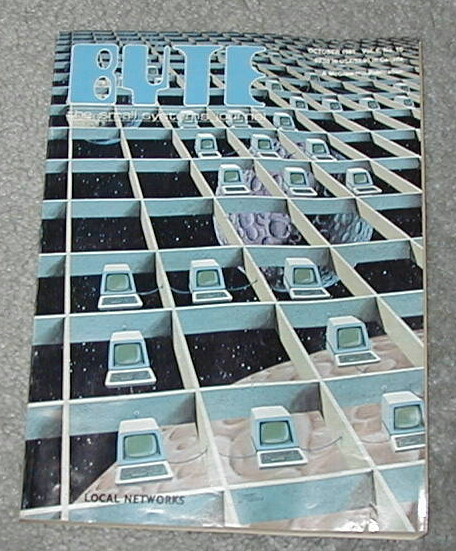
BYTE was produced in New Hampshire and had a scholarly tone; still, the emerging world of computing was breathlessly covered, and offered a sense of endless possibility. But it was Antic magazine (a specialty computing magazine for Atari computers), specifically the December 1983 “Buyer’s Guide” issue that really caught my eye.
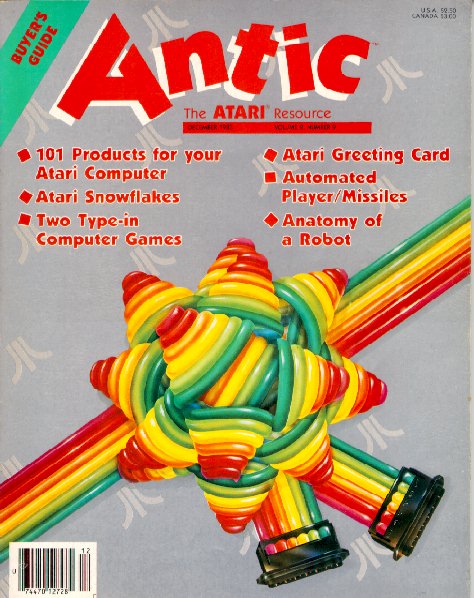
The design was colorful and imaginative, with beautiful typography, and the magazine was full of amazing ideas and products which I was sure would launch me on my way to unlimited exploration. I devoured the magazine cover to cover, but I never realized just how much I was soaking up its design ethos. Colorful, playful, and bold, this was not the wry, academic BYTE. It was combining the substance of tech with the emerging design scene in San Francisco, and it resonated with me profoundly.
In 1985, I got a job at a local computer store doing what I loved: selling computers and software and, yes, copies of Antic magazine. In 1986, I started my own computer and software sales company, Toad Computers. In 1989, months after graduating from high school, I had the chance to visit Antic Magazine — this time as an advertiser.
This was my first trip to San Francisco and I visited Antic at their loft office, located at 544 Second Street, right in the heart of the city’s SOMA district. But this was SOMA before it was the SOMA we know now as the home of so many startup tech companies. Beat up and edgy, the open-air second floor office had high-beamed ceilings and gave a sense of history and limitless potential. I was smitten with the city and with valley tech culture – I also visited Atari’s headquarters in Sunnyvale that trip – and absorbed all that I saw.
Later in 1993, I was twenty-one and searching for new things to explore. Toad Computers was doing well but I knew that it would have to change and grow to survive. Atari was having tough times. Antic magazine had folded. To advertise effectively we were sending out massive catalog mailings, featuring 56 page catalogs that I personally designed – very much in the visual style of Antic magazine.
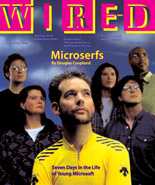
Someone had told me about a new magazine called Wired. I picked up a copy and was immediately struck with its sense of visual design and its aura of infinite possibility through the combination of design and tech. Again, I ingested every word, photo, and illustration in each issue. In early 1994, I noticed an ad that indicated that Wired – this tiny publishing startup – was looking for a circulation manager. I was entranced at the possibility. With my background in direct marketing and managing big catalog mailing lists, I thought this might be an opportunity for me.
In February 1994, I booked a trip to San Francisco to talk to my kindred spirits at Wired about the possibility of working there. I also became entranced with the Internet and its possibilities at this time, and for several days before my trip to San Francisco, I worked feverishly to write an article for Wired about how the Internet – when it became fully developed and evolved – could become a kind of real-time Jungian web of knowledge that acted like a global brain cheap kamagra oral jelly uk. I theorized that the Internet could become a kind of collective consciousness that enabled humanity’s genius to be available to everyone all the time. I predicted online banking, shopping, and video chat and made illustrations to show how these things would work.
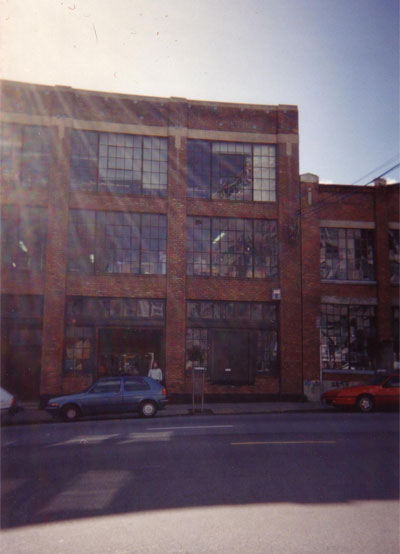
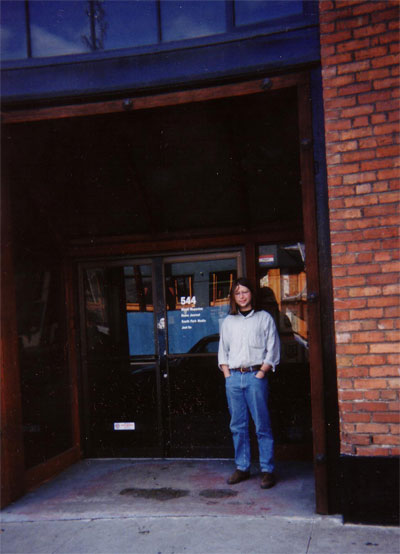
Me, with long hair, at Wired HQ in February 1994
Of course, the simple things were not hard to predict at that time, though they were still a few years off. But my central thesis about Jungian synchronicity was just too wacko to print in 1994. And to be fair, I had cobbled the article together in just a couple of days, had worked in ample quotes from Marshall McLuhan and Carl Jung, and had interviewed no one. My thesis may have been strong, but the piece would have benefited from some interviews and editing. But hey, I was inspired and twenty-two.
When I went to Wired’s offices, I was stunned to learn that they were located in the same office that Antic had occupied! The same open air loft office at 544 Second Street. I met with some folks from Wired’s barebones staff. I commented on my perceived sense of Jungian synchronicity — about Antic and Wired sharing the same office space. We talked about job possibilities. I submitted my article.
I didn’t get a job, and they didn’t print my article. To be fair, I wasn’t really ready to move to San Francisco, and I am sure they sensed that. I also wasn’t sure what I wanted. I just knew that I was drawn to this hopeful admixture of design and tech that seemed to emanate, radio-like, from 544 Second St.
In March 2007, two weeks after I had built Twittervision and a week after SXSW launched Twitter onto the early adopter stage, I thought it would be fun to stop by Twitter HQ in San Francisco. I met Biz and Jack and Ev, and was once again amazed to see that something I had been drawn to had come from SOMA; just a few blocks from 544 Second St. And ironically, it is now Twitter and the “Real Time Web” that is beginning to enable the kind of global consciousness that I had predicted in 1994.
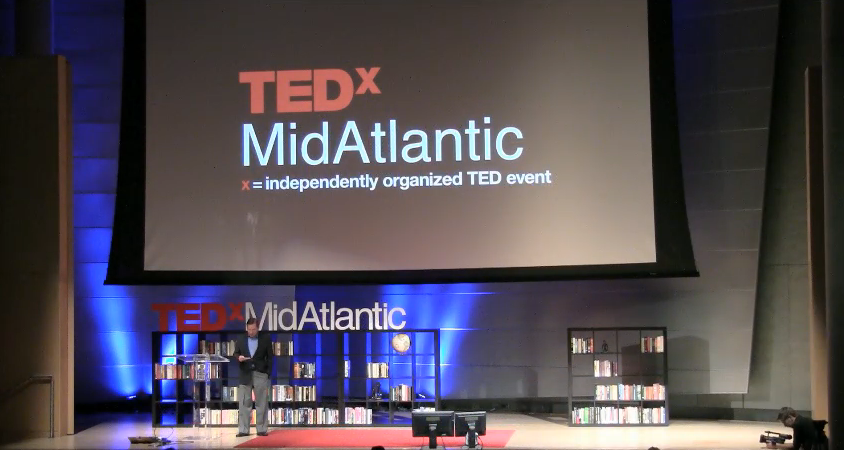
This past Thursday at TEDxMidAtlantic (of which I was the lead organizer and curator) in Baltimore, I was struck by the beautiful design of our stage set. (Thanks to Paul Wolman at Feats, Inc. for bringing it together for us!) A simple combination of bookshelves, cut lettering, books, a few objects and blue wash backlighting had combined to produce a gorgeous backdrop for the extraordinary ideas that our speakers would soon be sharing. And I felt at home. I could not go to 544 Second Street and SOMA. Instead, it was my mission to bring it here.
September 29th, 2009 — art, baltimore, business, design, economics, geography, social media
This was originally written as a guest post on Gus Sentementes’ BaltTech blog for the Baltimore Sun.
If you had 5 minutes on stage and 20 slides that rotate automatically every 15 seconds, what would you say? That’s the question that 48 presenters will answer at three upcoming Ignite events in Annapolis, D.C., and Baltimore.
Ignite was started in Seattle in 2006 by Brady Forrest and Bre Pettis, and is overseen by the technology book publisher O’Reilly. Since the founding of the program, hundreds of five minute talks have been given across the world.
The first Ignite event in the area, Ignite Baltimore, was organized in October 2008 by local entrepreneurs Mike Subelsky and Patti Chan and was an immediate success. Held at the Windup Space on North Avenue, the event has attracted standing room only crowds, and the upcoming Ignite Baltimore #4 has been moved to The Walters Art Museum in order to accommodate more people. Ignite Baltimore #4 will take place on Oct. 22. Ignite Baltimore was recently named “Best Geek’s Night Out” by Baltimore Magazine.
This week, the first Ignite Annapolis will be held at Loews Annapolis Hotel in their Powerhouse building. Ignite Annapolis is organized by Kris Valerio (Executive Director of Chesapeake Regional Tech Council, and local actress and theater director) and Jennifer Troy (local entrepreneur) and will take place on Thursday, Oct. 1. The event is sold out, but you may be able to get in if you show up early.
And next week, Ignite DC returns with its second event organized by Jared Goralnick (local entrepreneur and organizer) and Steve Lickteig (radio producer). That event will be held at Town Danceboutique, 2009 8th St NW and should feature several hundred people.
While a handful of well-connected area geeks will likely attend all three events, they are inherently local events designed to connect communities together, and really aren’t all that geeky. Topics span everything from art, history, science, philosophy, and of course, some tech and social media. But Ignite is designed to emphasize that tech has become inherently cross-discipline and is no longer the domain of just infotech nerds. So don’t be surprised when topics roam far and wide.
You can get a taste of Ignite by visiting http://ignite.oreilly.com/show/ and viewing some of the videos available there.
Upcoming Area Ignite Events
• October 1, 6:00pm – Ignite Annapolis, http://igniteannapolis.com
• October 8, 6:00pm – Ignite DC, http://ignite-dc.com
• October 22, 6:00pm – Ignite Baltimore, http://ignitebaltimore.com
Note that all three events are already sold out or close to sold out, so if you have not already registered, space will be very limited. However, you may be able to get in if you show up by 5:00. See the RSVP and waitlist policies for each individual event. And if you can’t make these events, get ready for the next round of Ignites, which will be happening early next year. Ignite Baltimore #5 is planned for the first week of March 2010.
July 1st, 2009 — baltimore, design, economics, geography, politics, travel, trends
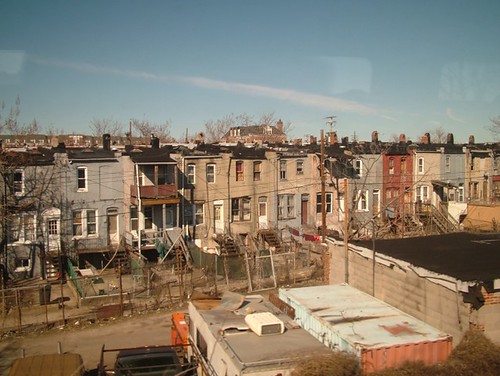
Approaching Baltimore by train from the north, as thousands do each day, a story unfolds.
You see the lone First Mariner tower off in the distance of Canton, and the new Legg Mason building unfolding in Harbor East.
Quickly, you are in the depths of northeast Baltimore. You see the iconic Johns Hopkins logo emblazoned on what appears to be a citadel of institutional hegemony. It is a sprawling campus of unknown purpose, insulated from the decay that surrounds it.
Your eyes are caught by some rowhouses that are burned out. Then some more: rowhouses you can see through front to back. Rowhouses that look like they are slowly melting. Rowhouses with junk, antennas, laundry, piles of God-knows-what out back. Not good. Scary, in fact. Ugly, at least.
Then a recent-ish sign proclaimig “The *New* East Baltimore.” Visitors are shocked to see that the great Johns Hopkins (whatever it all is, they’ve just heard of it and don’t know the University and the Hospital are not colocated) is surrounded by such obvious blight.
Viewers are then thrust into the Pennsylvania Railroad Tunnel where they fester, shell-shocked for two minutes while they gather their bags to disembark at Penn Station, wondering if the city they are about to embark into will be the hell for which they just saw the trailer.
Appearances matter. Impressions matter. One task that social entrepreneurs could take on to improve the perception (and the reality) of Baltimore would be simply this: make Baltimore look better from the train.
We know that the reality of Baltimore is rich, complex, historic, beautiful and hopeful. We ought to use the power of aesthetics and design to help the rest of the world begin to see the better parts of the city we love.
Author’s Note: my father-in-law Colby Rucker was the one that first pointed out to me how awful Baltimore looks from the train. It was on a train trip from New York to Baltimore today that I was inspired to jot down this thought.
If you would like to read a good book about how places can make you feel and convey important impressions, read The Experience of Place (1991) by Tony Hiss (son of the controversial Alger Hiss). They were both Baltimoreans.
June 3rd, 2009 — baltimore, business, design, economics, geography, mobile, politics, social media, trends
Here in Baltimore there is a great deal of uncertainty about the future of journalism, as there is everywhere. I have been involved in organizing some efforts by local new media publishers to study options for the future; my interest in this topic is purely personal.
Yesterday I attended a two-hour symposium arranged by the University of Maryland’s Merrill School of Journalism. In attendance on this panel were Monty Cook (Editor, Baltimore Sun), Tim Franklin (Former editor, Baltimore Sun), Jayne Miller (WBAL Television), Jake Oliver (Afro American Newspapers), Mark Potts (founder, WashingtonPost.com). It was moderated by Kevin Klose (former president, NPR) and sponsored by Abell Professor Sandy Banisky.
The discussion was mostly a paean to times long gone: to well-staffed newsrooms rich with sources, and benefit plans to match. It was an apologia from television to print, explicating the ability that cable-subscriber funded news operations have had to survive via subsidies that the press could never extract. It was a cursory overview of myriad efforts to invent new modes of journalism online. And it was a predictable declaration of heresy: “these so-called wanna-be websites” (Jake Oliver) “will never hold a candle to traditional journalism.” (Jayne Miller)
I quote directly.
And herein lies the problem. As observers, these trained journalists accurately state that a small, unfunded website run by “these kids” (many of whom are 20 year veterans of the press) can not effectively compete with some imagined newsroom of the past. However, these “small unfunded websites” are just starting out. They will grow. And these imagined news operations no longer exist, and the ones that still do are shrinking. The old and the new are on a collision course.
While the traditional media sticks its head in the sand and belittles the startup efforts of entrepreneurs and journalists, the world is shifting beneath its feet. And all the time spent on internal infighting, in denial, in testimony before congress, and in bankruptcy courts is time not spent reinventing the future of journalism. Their legacy costs, on health plans and labor unions and real estate and “right-sizing” are costs that aren’t being spent solving the market need.
What are the odds that the existing companies (the ones with the problem) will be the ones who come up with the solution? They are astronomically small. That’s almost never how things play out in markets.
A new, reasonably-funded journalistic startup today has access to all kinds of assets: a large pool of trained, laid-off journalists; incredible inexpensive distribution technology in the form of web, mobile, and Kindle; a motivated pool of citizen journalists; and most importantly, a startup mindset that is focused on being lean, nimble, and experimentational.
If I had to bet on whether a bloated 172-year old company that’s in bankruptcy will find the model, or whether it would be one of a field of startups, I’d bet on the field of startups every time. Why wouldn’t you?
The only coherent argument against new startups is really one of mass and heft – both in terms of startup capital and in terms of depth of connections. However, it is reasonable to expect that a reasonably-funded startup staffed with experienced businesspeople and journalists is going to be every bit as rich with contacts as a comparably-sized post-bankruptcy old-media concern. The difference? Less legacy DNA, less legacy expenses, and a lean, nimble, humble mindset that’s focused on finding the answers in an open market.
Failure of Imagination
Just as the failure to prevent the September 11 attacks was attributed to a “failure of imagination,” we see a comparable failure of imagination in journalism today.
The traditional media companies fail to imagine what the confluence of web, mobile, and citizen journalism might ultimately be able to deliver, and that it might be better than anything journalism has delivered to date.
Potential funders see all options as risky and want to bet first on “traditional” outlets. They see these brands not only as less risky, but as a restoration to a prior order.
“Restorations” are not how markets work. Things don’t get restored. They are creatively torn apart and reassembled.
The first investors to imagine the possibilities present in new journalistic startups will ultimately reap the rewards; rewards which will never be seen again in newspaper companies.
The companies that bring you local news today will most likely not be around in 10 years. A host of new companies will take their place.
The only question for those in the industry today is whether they want to be part of those solutions.







